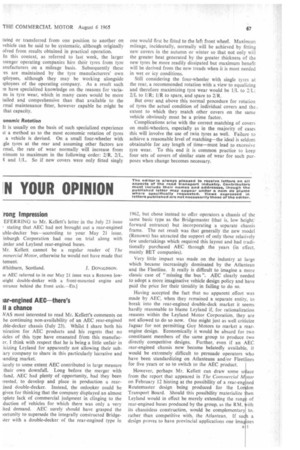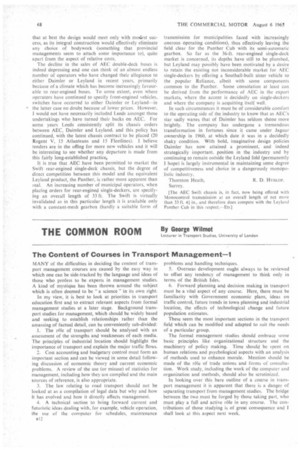N YOUR OPINION
Page 69

Page 70

If you've noticed an error in this article please click here to report it so we can fix it.
'rong Impression
EFERRING to Mr. Kellett's letter in the July 23 issue stating that AEC had not brought out a rear-engined uble-decker bus—according to your May 21 issue, inburgh Corporation had one on trial along with imler and Leyland rear-engined buses.
Mr. Kellett cannot be a regular reader of The mmercial Motor, otherwise he would not have made that tement.
nitbum, Scotland. J. DONALDSON_ 1e AEC referred to in our May 21 issue was a Renown loweight double-decker with a front-mounted engine and ntrance behind the front axle.—En.]
gir-engined AEC—there's II a chance
VAS most interested to read Mr. Kellett's comments on he continuing non-availability of an AEC rear-engined .Ible-decker chassis (July 23). Whilst I share both his niration for AEC products and his regrets that no tides of this type have emanated from this manufacel% I think with respect that he is being a little unfair in icizing Leyland for apparently not allowing their subLary company to share in this particularly lucrative and ■ anding market.
;urely to some extent AEC contributed in large measure their own downfall. Long before the merger with +land. AEC had plenty of opportunity, had they been !rested, to develop and place in production a rearmed double-decker. Instead, the onlooker could be given for thinking that the company displayed an almost iplete lack of commercial judgment in clinging to the duction of vehicles for which there was only a very ited demand. AEC surely should have grasped the lortunity to supersede the integrally constructed Bridge;ter with a double-decker of the rear-engined type in 1962, but chose instead to offer operators a chassis of the same basic type as the Bridgemaster (that is, low height/ forward entrance) but incorporating a separate chassis frame. The net result was that generally the new model (Renown) has attracted the support of only those relatively few undertakings which required this layout and had traditionally purchased AEC through the years (in effect, mainly BET companies).
Very little impact was made on the industry at large which became increasingly dominated by the Atlantean and the Fleetline. It really is difficult to imagine a more classic case of "missing the bus ". AEC clearly needed to adopt a more imaginative vehicle design policy and have paid the price for their timidity in failing to do so.
Having accepted the fact that no apparent .effort was made by AEC, when they remained a separate entity, to break into the rear-engined double-deck market it seems hardly reasonable to blame Leyland if, for rationalization reasons within the Leyland Motor Corporation, they are not allowed to do so now. One might just as well criticize Jaguar for not permitting Guy Motors to market a rearengine design. Economically it would be absurd for two constituent members of the same group to produce two directly competitive designs. Further, even if an AEC rear-engined chassis now became belatedly available, it would be extremely difficult to persuade operators who have been standardizing on Atlanteans and/or Fleetlines for five years or so to switch to the AEC product.
However, perhaps Mr. Kellett can draw some s ace from the report that appeared in The Commercial M tor on February 12 hinting at the possibility of a rear-eng ned Routemaster design being produced for the Lon on Transport Board. Should this possibility materialize hen Leyland would in effect be merely extending the rang of rear-engined buses produced by the group, as the RM. ith its chassisless construction, would be complementar to.
rather than competitive with. the Atlantean. If su a design proves to have provincial applications one ima ines that at best the design would meet only with moe:st success, as its integral construction would effectively eliminate any choice of bodywork (something that provincial managements seem to attach some importance to), quite apart from the aspect of relative costs.
The decline in the sales of AEC double-deck buses is indeed depressing and one can think of an almost endless number of operators who have changed their allegiance to either Daimler or Leyland in recent years, primarily because of a climate which has become increasingly favourable to rear-engined buses. To some extent, even where operators have continued to specify front-engined vehicles, switches have occurred to either Daimler or Leyland—in • the latter case no doubt because of lower prices. However, I would not have necessarily included Leeds amongst those undertakings who have turned their backs on AEC. For some years Leeds consistently split its chassis orders between AEC, Daimler and Leyland, and this policy has continued, with the latest chassis contract to be placed (20 Regent V, 15 Atlanteans and 15 Fleetlines). I believe tenders are in the offing for more new vehicles and il will be interesting to see whether any departure is made from this fairly long-established practice, It is true that AEC have been permitted to market the Swift rear-engined single-deck chassis, but the degree of direct competition between this model and the equivalent Leyland product, the Panther, is rather more apparent than real. An increasing number of municipal operators, when placing orders for rear-engined single-deckers, are specifying an overall length of 33 ft. The Swift is virtually invalidated as in this particular length it is available only with a constant-mesh gearbox (hardly a suitable form of
transmission for municipalities faced with increasingly onerous operating conditions), thus effectively leaving the field clear for the Panther Cub with its semi-automatic gearbox. So far as the 36-ft. rear-engined single-deck market is concerned, its depths have still to be plumbed, but Leyland may possibly have been motivated by a desire to retain the existing not inconsiderable market for AEC single-deckers by offering a Southall-built sister vehicle to the popular Reliance, albeit with some components common to the Panther. Some consolation at least can be derived from the performance of AEC in the export markets, where the accent is decidedly on single-deckers and where the company is acquitting itself well.
In such circumstances it must be of considerable comfort to the operating side of the industry to know that as AEC's star sadly wanes that of Daimler has seldom shone more brightly. The company has undergone a tremendous transformation in fortunes since it came under Jaguar ownership in 1960, at which date it was in a decidedly shaky condition. With bold, imaginative design policies Daimler has now attained a prominent, and indeed strategically important. position in the industry and by continuing to remain outside the Leyland fold (permanently 1 hope) is largely instrumental in maintaining some degree of competitiveness and choice in a dangerously monopolistic industry.
Thornton Heath, R. D. HvsLoP. Surrey.
[The AEC Swift chassis is, in fact, now being offered with Monocontrol transmission at an overall length of not more than 33 ft. 41in., and therefore does compete with the Leyland Panther Cub in this respect—ED.]












































































































